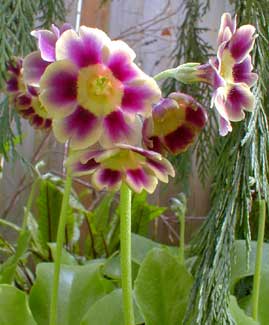
Can Household Ammonia
be Used as a Source
of Nitrogen in the Garden?
Illustrated with
a portrait of Mountain Cowslip
Jerry Baker, "America's Master Gardener," in his book Backyard Problem Solver, recommends household ammonia, the kind you can get for scant pennies in any grocery store, as a source of nitrogen in fertilizing the garden.
I've heard so many bad bits of advice blamed on Baker that I've come to regard him as something of an idiot savant, but without the savant. His advice for ammonia isn't baseless, but it's not ideal. It has roughly the same effect as having the dog pee on your plants. Or peeing on them yourself. It can be benificial or not, a little unpredictably, depending on soil type & the amount of urea & ammonia in the pee.
A teaspoon to a tablespoon of ammonia per gallon of water won't kill the plants, & some people other than Jerry Baker do recommend it as a mild nitrogen fertilizer. However, anhydrous ammonia converts to nitrogen very slowly & ends up delivering very little nitrogen even in acidic soil. In alkaline soil it converts hardly at all. In either case it will likely wash through the soil from watering & rainfall before it has done much good in the nitrogen department. The least wash-through will occur in clayey soils that do not drain well, but the majority of gardened plants will not thrive in soil that doesn't drain.
If you have alkaline soils, there will be no nitrogen effect, so some have suggested adding twice as much vinegar as ammonia to that gallon of water, in order to acidify the soil while the dilute ammonia is poored around a plant. Tinkering randomly with pH is not necessarily a good thing for the plants, however, & it remains that rainfall & average watering will wash the ammonia out of the soil before it breaks down into nitrogen.
Additionally, surface evaporation of ammonia means it is just carried away on the wind. Dilute ammonia placed in the garden while the temperature is above about 50 degrees F. evaporates more swiftly than if applied on a cold day. Yet a warm day is essential if microorganism activity is to be at maximum. If the ammonia is applied on a cold day it does not stimulate the microorganisms which process the nitrogen, but if applied on a warm day it evaporates before it can be processed by plants or by microorganisms.
Additionally, check labels before using ammonia in the garden, as some ammonia is sold with other ingredients mixed with it, useful only as cleaning solutions.
Good nitrogen production is done by microorganisms in the soil, not by adding chemicals which upset the microorganism balance. If the ammonia or ammonia-&-vinegar soil-rinses managed to kill rather than enhance microorganisms, you'll have done more harm than good.
Ammonia nitrate or other forms of ammonia are a common ingredient in balanced commercial fertilizers. These tend to be more stable (less evaporative), & in granular forms do not instantly wash out of the soil. The money saved by using a cheaper household chemical is probably not really much of a savings since it is apt to work unpredictably, inadequately, or not at all.
But fertilizers in general are over-utilized in gardens, as encouraged by vendors & the chemical industry, rather than by sensible horticultural practices. For a vegetable garden or fruit orchard which is regularly harvested, or a lawn with clippings discarded rather than mulch-mowed, soil is being constantly depleted & may indeed require regular artificial feeding to remain productive. But ornamental gardens where everything is recycled back into the garden rather than carted away to eat or discard, chemical fertilization is not half so essential.
Rather than dousing with dilute ammonia, you'll get better nitrogen in the soil by mixing in some composted steer manure & alfalfa powder & keeping the area moist.
This isn't because there's lots of nitrogen in manure compost or in alfalfa (there isn't); it's because these encourage the required microorganisms to produce nitrogen continuously, as it is required, in a form that is the most accessible to plants.